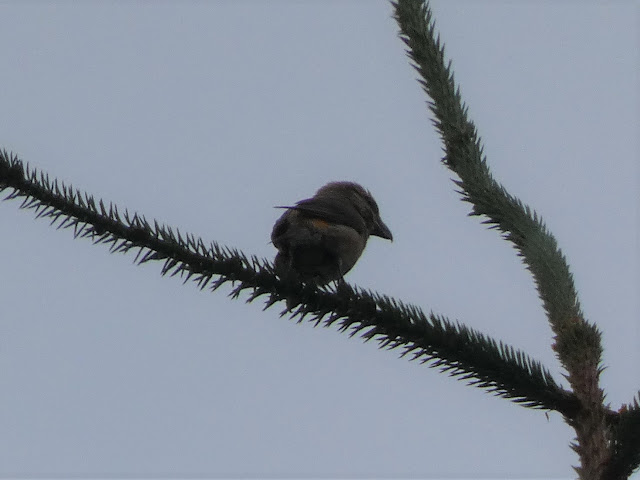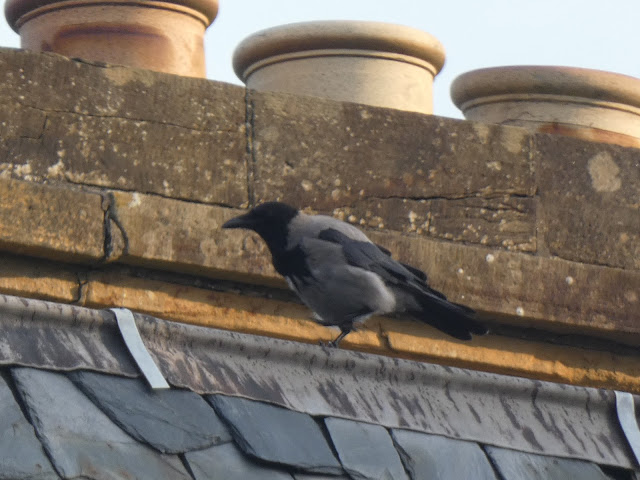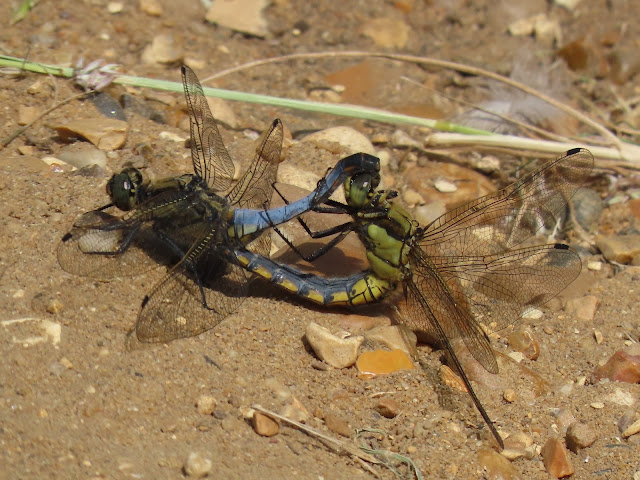I had a rare visit out of London on July 1st, albeit not
that far out with a day trip to Box Hill with friends. Principally a trip for
butterflies it usually turns into a general nature walk, often beginning with
looking for moths at the underpass. This time was pretty good with
Swallow-tailed Moth being the best.
.JPG) |
| Common Footman |
.JPG) |
| Marbled White Spot |
.JPG) |
| Riband Wave |
.JPG) |
| Swallow-tailed Moth |
We began the slow climb up the steep slope, finding
Pyramidal and Common Spotted Orchids although the latter were going over compared to last year when we were here at exactly the same time.
.JPG) |
| Common Spotted Orchids |
.JPG) |
| Common Spotted Orchid |
.JPG) |
| Pyramidal Orchid |
There were plenty of butterflies on the wing including
Marbled Whites, Ringlets and the hoped for Dark Green Fritillaries. Once we
reached the top of the hill it was time to admire the views and have a short
rest.
.JPG) |
| Dark Green Fritillary |
.JPG) |
| Marbled White |
We walked along the ridge path, stopping to look at the
headstone of a local who chose to be buried vertically before we reached the
National Trust car park and cafe.
After a pause for hot drinks we had a look over the road,
adding a brief Silver-washed Fritillary to the butterfly list. Usually we take
the stepped path down to the river but it was closed for repairs which
according to the signs should have been finished several weeks ago. So we had
to descend the hill and walk around to the river where we stopped for lunch. As
we got back to the station a Little Egret flew over and we heard our first
pesky parrot of the day, a recent arrival in the area.
On Saturday I popped down to the Wetland Centre for a few
hours. I wasn’t expecting to see much although recent reports of Black-tailed
Godwit and Wood Sand suggested there may be some waders. In the event there was
no movement and the only waders were local breeders including a pair of
Oystercatchers with two half-grown young. One of the adults sat on an island
and called to them continuously as if trying to get them to come over but as
they bred on a raft the young will have to stay there until they’re much older
and can fly. A pair of Little Ringed Plovers were unaccompanied by any young so
presumably failed to breed this year.
The following day I went to a new area: Ten Acre Wood and
Gutteridge Wood, collectively called Yeading Woods. Surrounded by meadows and a
golf course that’s in construction this large green space in suburban west
London has a lot of potential. It’s been an area I had wanted to visit but
wasn’t quite sure how to access it so a friend showed me around the place. July
isn’t the best time to visit but we did see several Red Kites which presumably
breed nearby, including what I think is the first one I’ve actually seen
perched in London.
.JPG) |
| Haven't identified this fungus yet |
.JPG) |
| Red Kite |
We also saw Common Buzzard, Sparrowhawk, Kestrel and heard a
singing Skylark. Hopefully, I’ll get back here later in the year.
I was back in West London the next day, this time at Staines
Res where I was hoping to catch up with a Red-necked Grebe that had been
present for the previous few days. A couple of local birders on the causeway
told me where they had last seen it and after a few minutes scanning I picked
it up, swimming against the north bank on the north basin. It was an adult in
summer plumage so looked very smart despite the distant views. It’s been a long
time since I’ve seen one in this plumage and as I didn’t go for the one on KGV
earlier in the year it becomes number 171 on my London year list, the first
addition for a month.
Also on the reservoirs were a little gaggle of Egyptian
Geese, the first ones I’ve seen here and six Black-necked Grebes, all in summer
plumage. Two of these were close to the causeway, giving great views and were
even calling as well. On the banks I located a roosting Black-tailed Godwit but
I didn’t venture to the other end of the causeway to look for the pair of
Oystercatchers that were there.
.JPG) |
| Black-necked Grebe |
.JPG) |
| Egyptian Geese |
Instead I left early to head over to Kensington Gardens to
search for Little Owl. It meant taking the train back to Waterloo then the tube
up to Lancaster Gate. By the time I arrived it was lunchtime and quite hot as
well as heaving with people so it wasn’t a great time to be looking for these
birds. I wandered down towards the Round Pond and checked the area out but
couldn’t find any. At one point I heard some mobbing so I paused my lunch and
went to investigate. A pair of Chaffinches were berating a Magpie that was
eating something in their tree, possible one of their nestlings.
With no hurry to get home I took a bus up the Edgware Road
to look out for interesting restaurants to visit at a later date.
I managed a couple of visits to Brent during the week. There
hadn’t been much change since last week with a few Lapwing, Green and Common
Sands around but one of the breeding pairs of Common Terns had hatched a chick.
On the intervening day I joined a Herts & Middx
Butterfly walk at Ruislip Woods. I met my friends at Wembley Park and we took
the Met Line to Ruislip where we ran into Neil at the bus stop. At the Lido
there was time for coffee and cake at one of the beachside cafes before the
walk started.
The group set off at 10.30 and headed into a meadow to look
for butterflies and whatever else took our interest including moths, ladybirds,
flowers and birds. We entered the woods and found the two main targets there:
White Admiral and Silver-washed Fritillary. It’s been a long time since I’ve
seen White Admiral so it was good to catch up with it again although they
didn’t settle for photos. We worked our way along Poors Field over to the
northern side where the Purple Emperor spot is.
.JPG) |
| Silver-washed Fritillary |
We had lunch and waited for the sun to come out but the
overcast conditions meant we only had fleeting glimpses of one probable Purple
Emperor over the canopy. Rather than walk all the way back to the Lido we
walked the short distance to the local bus stop and took the bus to Northwood
Hills station.
On Friday I decided it was time to visit Rainham for the
first time in over a month. With an early start I arrived at Rainham station at
07.30 and by the time I started walking through Rainham West it was already
fairly hot. A few warblers were still singing but most of the Cetti’s had now
shut up as they undergo their post-breeding moult.
Looking out from Serin Mound almost all the pools had dried
up but I did manage to find a solitary Avocet. It was high tide in Aveley Bay
so there weren’t any waders there either. I did a circuit of the reserve but it
was pretty hot and there wasn’t a lot moving. Purfleet scrape only had a little
water in it but there were no birds there as there was someone cutting the
vegetation in front of the hide.
I had a look in the Cordite in case the Long-eared Owl was
back but it wasn’t so plodded on to the KB hide. The Great Crested Grebes had
bred successfully and a well grown youngster was following its parents around.
In front of Butts Hide there were three juvenile Little Ringed Plovers and a
group of feisty Little Egrets which kept chasing each other off. The best
sighting was at the dragonfly pond which was almost dry but a male Bearded Tit
was feeding on the mud the whole time I was there. At least one juvenile also
came in but didn’t hang around.
.JPG) |
| Bearded Tit |
.JPG)
.JPG)
.JPG)
.JPG)
.JPG)
.JPG)
.JPG)
.JPG)
.JPG)
.JPG)
.JPG)
.JPG)
.JPG)
.JPG)
.JPG)
.JPG)
.JPG)
.JPG)
.JPG)
.JPG)
.JPG)
.JPG)
.JPG)
.JPG)
.JPG)
.JPG)
.JPG)
.JPG)
.JPG)
.JPG)
.JPG)
.JPG)
.JPG)
.JPG)
.JPG)
.JPG)
.JPG)
.JPG)
.JPG)
.JPG)
.JPG)
.JPG)
.JPG)
.JPG)
.JPG)
.JPG)
.JPG)
.JPG)
.JPG)
.JPG)
.JPG)
.JPG)
.JPG)
.JPG)
.JPG)



